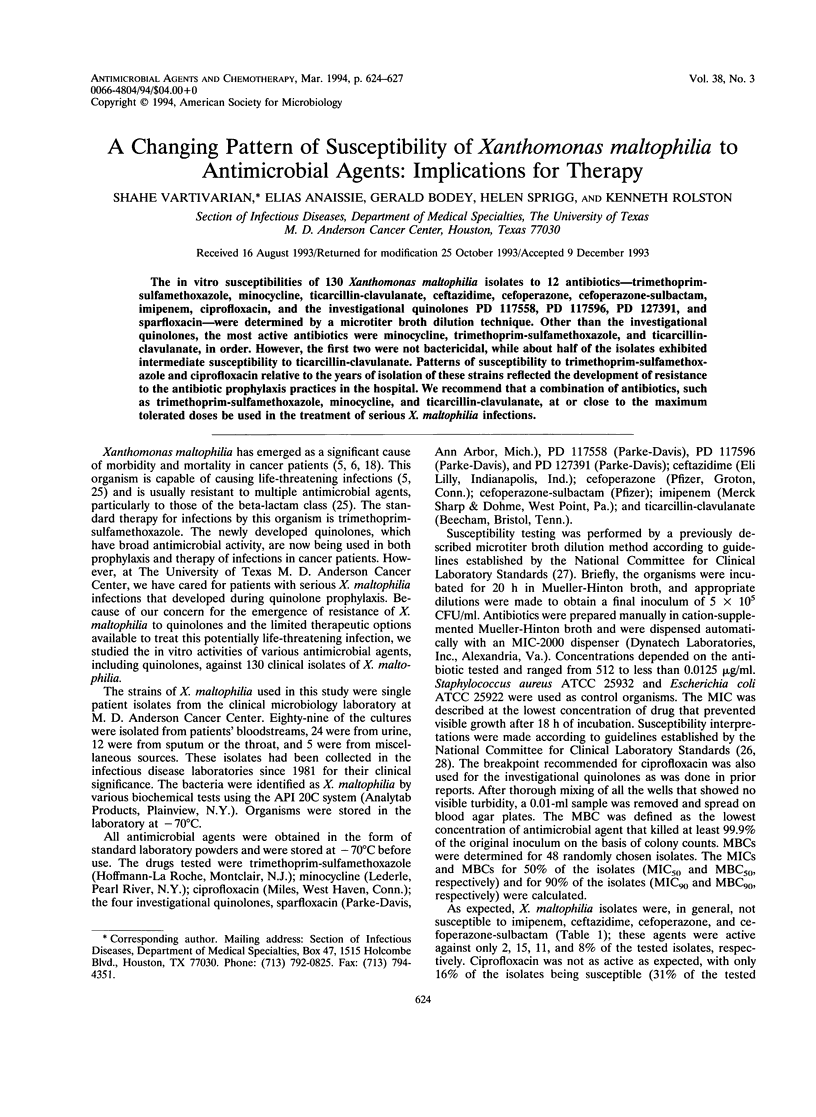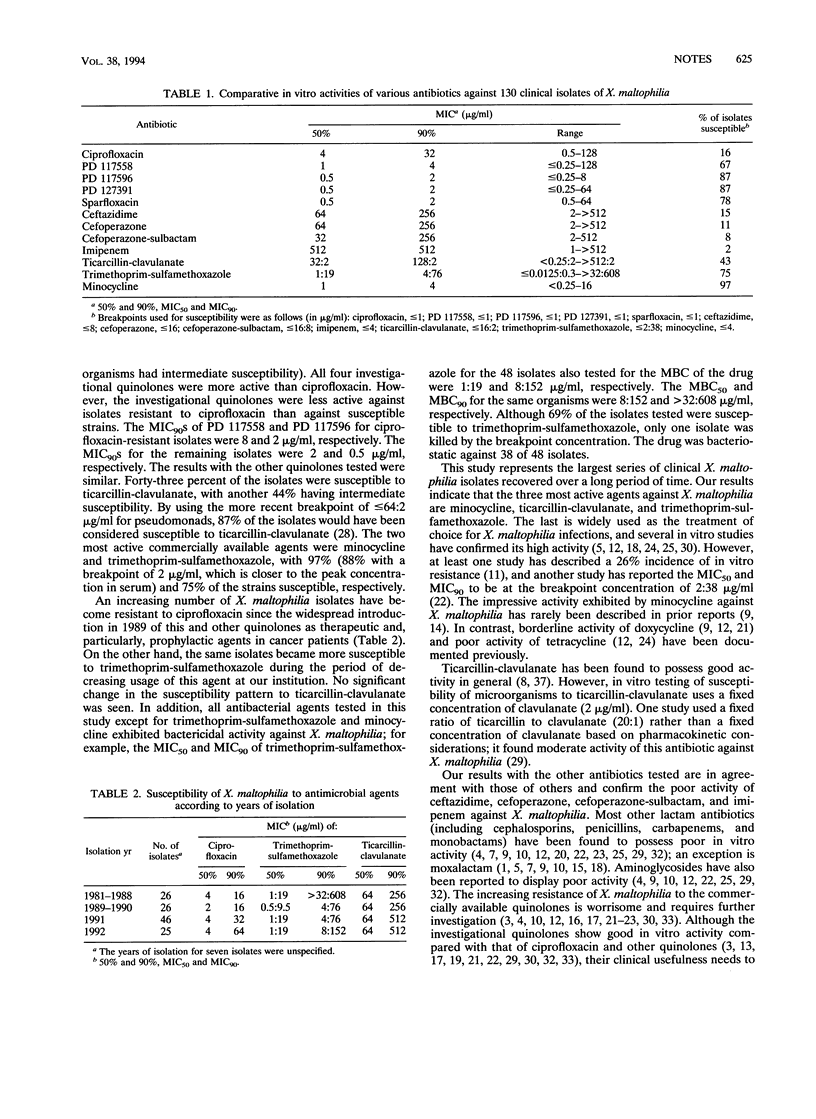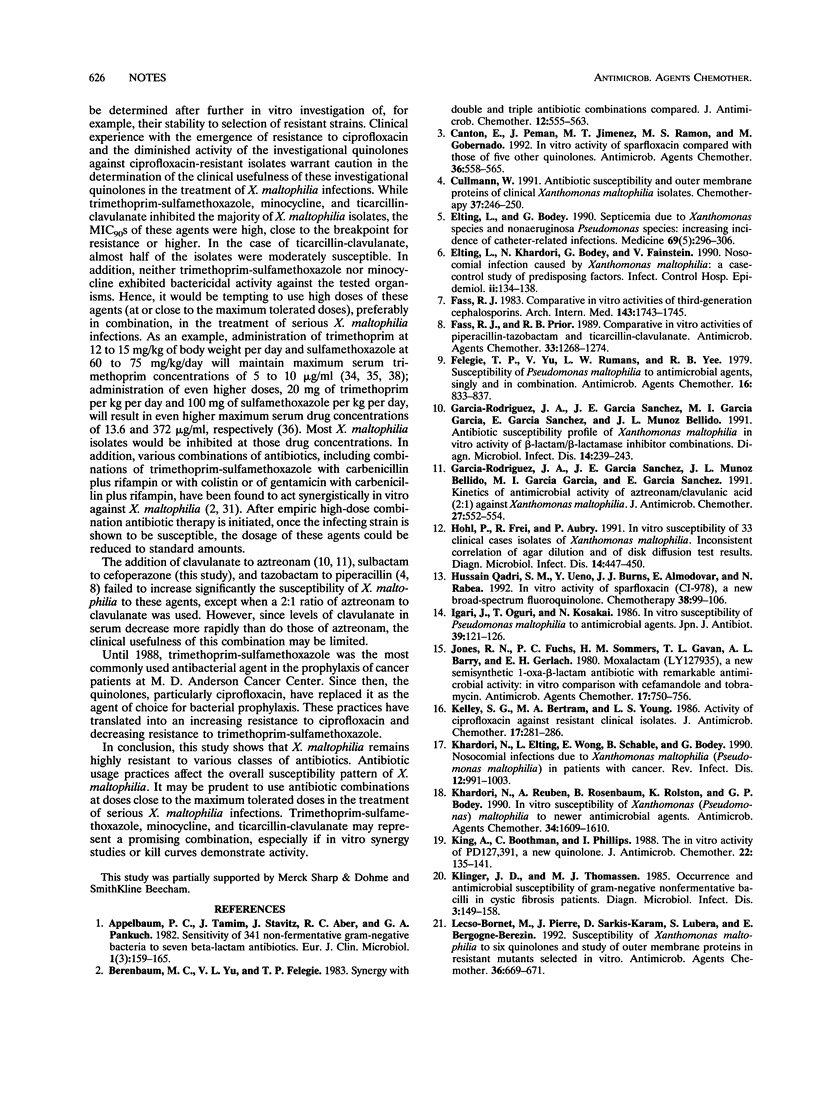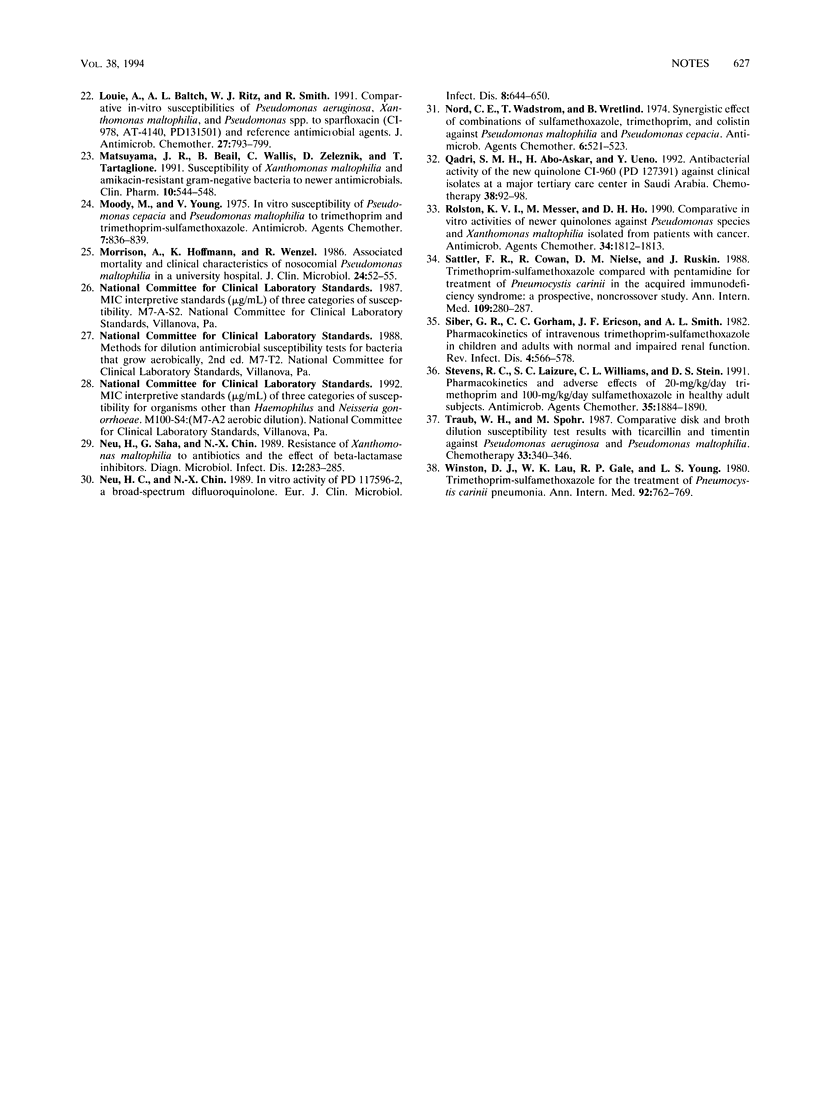Abstract
The in vitro susceptibilities of 130 Xanthomonas maltophilia isolates to 12 antibiotics--trimethoprim-sulfamethoxazole, minocycline, ticarcillin-clavulanate, ceftazidime, cefoperazone, cefoperazone-sulbactam, imipenem, ciprofloxacin, and the investigational quinolones PD 117558, PD 117596, PD 127391, and sparfloxacin--were determined by a microtiter broth dilution technique. Other than the investigational quinolones, the most active antibiotics were minocycline, trimethoprim-sulfamethoxazole, and ticarcillin-clavulanate, in order. However, the first two were not bactericidal, while about half of the isolates exhibited intermediate susceptibility to ticarcillin-clavulanate. Patterns of susceptibility to trimethoprim-sulfamethoxazole and ciprofloxacin relative to the years of isolation of these strains reflected the development of resistance to the antibiotic prophylaxis practices in the hospital. We recommend that a combination of antibiotics, such as trimethoprim-sulfamethoxazole, minocycline, and ticarcillin-clavulanate, at or close to the maximum tolerated doses be in the treatment of serious X. maltophilia infections.
Full text
PDF



Selected References
These references are in PubMed. This may not be the complete list of references from this article.
- Appelbaum P. C., Tamim J., Stavitz J., Aber R. C., Pankuch G. A. Sensitivity of 341 non-fermentative gram-negative bacteria to seven beta-lactam antibiotics. Eur J Clin Microbiol. 1982 Jun;1(3):159–165. doi: 10.1007/BF02019617. [DOI] [PubMed] [Google Scholar]
- Berenbaum M. C., Yu V. L., Felegie T. P. Synergy with double and triple antibiotic combinations compared. J Antimicrob Chemother. 1983 Dec;12(6):555–563. doi: 10.1093/jac/12.6.555. [DOI] [PubMed] [Google Scholar]
- Cantón E., Pemán J., Jimenez M. T., Ramón M. S., Gobernado M. In vitro activity of sparfloxacin compared with those of five other quinolones. Antimicrob Agents Chemother. 1992 Mar;36(3):558–565. doi: 10.1128/aac.36.3.558. [DOI] [PMC free article] [PubMed] [Google Scholar]
- Cullmann W. Antibiotic susceptibility and outer membrane proteins of clinical Xanthomonas maltophilia isolates. Chemotherapy. 1991;37(4):246–250. doi: 10.1159/000238862. [DOI] [PubMed] [Google Scholar]
- Elting L. S., Bodey G. P. Septicemia due to Xanthomonas species and non-aeruginosa Pseudomonas species: increasing incidence of catheter-related infections. Medicine (Baltimore) 1990 Sep;69(5):296–306. doi: 10.1097/00005792-199009000-00003. [DOI] [PubMed] [Google Scholar]
- Elting L. S., Khardori N., Bodey G. P., Fainstein V. Nosocomial infection caused by Xanthomonas maltophilia: a case-control study of predisposing factors. Infect Control Hosp Epidemiol. 1990 Mar;11(3):134–138. doi: 10.1086/646136. [DOI] [PubMed] [Google Scholar]
- Fass R. J. Comparative in vitro activities of third-generation cephalosporins. Arch Intern Med. 1983 Sep;143(9):1743–1745. [PubMed] [Google Scholar]
- Fass R. J., Prior R. B. Comparative in vitro activities of piperacillin-tazobactam and ticarcillin-clavulanate. Antimicrob Agents Chemother. 1989 Aug;33(8):1268–1274. doi: 10.1128/aac.33.8.1268. [DOI] [PMC free article] [PubMed] [Google Scholar]
- Felegie T. P., Yu V. L., Rumans L. W., Yee R. B. Susceptibility of Pseudomonas maltophilia to antimicrobial agents, singly and in combination. Antimicrob Agents Chemother. 1979 Dec;16(6):833–837. doi: 10.1128/aac.16.6.833. [DOI] [PMC free article] [PubMed] [Google Scholar]
- García-Rodríguez J. A., García Sánchez J. E., García García M. I., García Sánchez E., Muñoz Bellido J. L. Antibiotic susceptibility profile of Xanthomonas maltophilia. In vitro activity of beta-lactam/beta-lactamase inhibitor combinations. Diagn Microbiol Infect Dis. 1991 May-Jun;14(3):239–243. doi: 10.1016/0732-8893(91)90038-h. [DOI] [PubMed] [Google Scholar]
- García-Rodríguez J. A., García Sánchez J. E., Muñoz Bellido J. L., García García M. I., García Sánchez E. Kinetics of antimicrobial activity of aztreonam/clavulanic acid (2:1) against Xanthomonas maltophilia. J Antimicrob Chemother. 1991 Apr;27(4):552–554. doi: 10.1093/jac/27.4.552. [DOI] [PubMed] [Google Scholar]
- Hohl P., Frei R., Aubry P. In vitro susceptibility of 33 clinical case isolates of Xanthomonas maltophilia. Inconsistent correlation of agar dilution and of disk diffusion test results. Diagn Microbiol Infect Dis. 1991 Sep-Oct;14(5):447–450. doi: 10.1016/0732-8893(91)90072-n. [DOI] [PubMed] [Google Scholar]
- Igari J., Oguri T., Kosakai N. In vitro susceptibility of Pseudomonas maltophilia to antimicrobial agents. Jpn J Antibiot. 1986 Jan;39(1):121–126. [PubMed] [Google Scholar]
- Jones R. N., Fuchs P. C., Sommers H. M., Gavan T. L., Barry A. L., Gerlach E. H. Moxalactam (LY127935), a new semisynthetic 1-oxa-beta-lactam antibiotic with remarkable antimicrobial activity: in vitro comparison with cefamandole and tobramycin. Antimicrob Agents Chemother. 1980 Apr;17(4):750–756. doi: 10.1128/aac.17.4.750. [DOI] [PMC free article] [PubMed] [Google Scholar]
- Kelley S. G., Bertram M. A., Young L. S. Activity of ciprofloxacin against resistant clinical isolates. J Antimicrob Chemother. 1986 Mar;17(3):281–286. doi: 10.1093/jac/17.3.281. [DOI] [PubMed] [Google Scholar]
- Khardori N., Elting L., Wong E., Schable B., Bodey G. P. Nosocomial infections due to Xanthomonas maltophilia (Pseudomonas maltophilia) in patients with cancer. Rev Infect Dis. 1990 Nov-Dec;12(6):997–1003. doi: 10.1093/clinids/12.6.997. [DOI] [PubMed] [Google Scholar]
- Khardori N., Reuben A., Rosenbaum B., Rolston K., Bodey G. P. In vitro susceptibility of Xanthomonas (Pseudomonas) maltophilia to newer antimicrobial agents. Antimicrob Agents Chemother. 1990 Aug;34(8):1609–1610. doi: 10.1128/aac.34.8.1609. [DOI] [PMC free article] [PubMed] [Google Scholar]
- King A., Boothman C., Phillips I. The in-vitro activity of PD127,391, a new quinolone. J Antimicrob Chemother. 1988 Aug;22(2):135–141. doi: 10.1093/jac/22.2.135. [DOI] [PubMed] [Google Scholar]
- Klinger J. D., Thomassen M. J. Occurrence and antimicrobial susceptibility of gram-negative nonfermentative bacilli in cystic fibrosis patients. Diagn Microbiol Infect Dis. 1985 Mar;3(2):149–158. doi: 10.1016/0732-8893(85)90025-2. [DOI] [PubMed] [Google Scholar]
- Lecso-Bornet M., Pierre J., Sarkis-Karam D., Lubera S., Bergogne-Berezin E. Susceptibility of Xanthomonas maltophilia to six quinolones and study of outer membrane proteins in resistant mutants selected in vitro. Antimicrob Agents Chemother. 1992 Mar;36(3):669–671. doi: 10.1128/aac.36.3.669. [DOI] [PMC free article] [PubMed] [Google Scholar]
- Louie A., Baltch A. L., Ritz W. J., Smith R. P. Comparative in-vitro susceptibilities of Pseudomonas aeruginosa, Xanthomonas maltophilia, and Pseudomonas spp. to sparfloxacin (CI-978, AT-4140, PD131501) and reference antimicrobial agents. J Antimicrob Chemother. 1991 Jun;27(6):793–799. doi: 10.1093/jac/27.6.793. [DOI] [PubMed] [Google Scholar]
- Matsuyama J. R., Beail B., Wallis C., Zeleznik D., Tartaglione T. Susceptibility of Xanthomonas maltophilia and amikacin-resistant gram-negative bacteria to newer antimicrobials. Clin Pharm. 1991 Jul;10(7):544–548. [PubMed] [Google Scholar]
- Moody M. R., Young W. M. In vitro susceptibility of Pseudomanas cepacia and Pseudomonas maltophilia to trimethoprim and trimethoprim-sulfamethoxazole. Antimicrob Agents Chemother. 1975 Jun;7(6):836–839. doi: 10.1128/aac.7.6.836. [DOI] [PMC free article] [PubMed] [Google Scholar]
- Morrison A. J., Jr, Hoffmann K. K., Wenzel R. P. Associated mortality and clinical characteristics of nosocomial Pseudomonas maltophilia in a university hospital. J Clin Microbiol. 1986 Jul;24(1):52–55. doi: 10.1128/jcm.24.1.52-55.1986. [DOI] [PMC free article] [PubMed] [Google Scholar]
- Neu H. C., Chin N. X. In vitro activity of PD 117596-2, a broad-spectrum difluoroquinolone. Eur J Clin Microbiol Infect Dis. 1989 Jul;8(7):644–650. doi: 10.1007/BF01968149. [DOI] [PubMed] [Google Scholar]
- Neu H. C., Saha G., Chin N. X. Resistance of Xanthomonas maltophilia to antibiotics and the effect of beta-lactamase inhibitors. Diagn Microbiol Infect Dis. 1989 May-Jun;12(3):283–285. doi: 10.1016/0732-8893(89)90030-8. [DOI] [PubMed] [Google Scholar]
- Nord C. E., Wadström T., Wretlind B. Synergistic effect of combinations of sulfamethoxazole, trimethoprim, and colistin against Pseudomonas maltophilia and Pseudomonas cepacia. Antimicrob Agents Chemother. 1974 Oct;6(4):521–523. doi: 10.1128/aac.6.4.521. [DOI] [PMC free article] [PubMed] [Google Scholar]
- Qadri S. M., Abo-Askar H., Ueno Y. Antibacterial activity of the new quinolone CI-960 (PD 127391) against clinical isolates at a major tertiary care center in Saudi Arabia. Chemotherapy. 1992;38(2):92–98. doi: 10.1159/000238947. [DOI] [PubMed] [Google Scholar]
- Qadri S. M., Ueno Y., Burns J. J., Almodovar E., Rabea N. In vitro activity of sparfloxacin (CI-978), a new broad-spectrum fluoroquinolone. Chemotherapy. 1992;38(2):99–106. doi: 10.1159/000238948. [DOI] [PubMed] [Google Scholar]
- Rolston K. V., Messer M., Ho D. H. Comparative in vitro activities of newer quinolones against Pseudomonas species and Xanthomonas maltophilia isolated from patients with cancer. Antimicrob Agents Chemother. 1990 Sep;34(9):1812–1813. doi: 10.1128/aac.34.9.1812. [DOI] [PMC free article] [PubMed] [Google Scholar]
- Sattler F. R., Cowan R., Nielsen D. M., Ruskin J. Trimethoprim-sulfamethoxazole compared with pentamidine for treatment of Pneumocystis carinii pneumonia in the acquired immunodeficiency syndrome. A prospective, noncrossover study. Ann Intern Med. 1988 Aug 15;109(4):280–287. doi: 10.7326/0003-4819-109-4-280. [DOI] [PubMed] [Google Scholar]
- Siber G. R., Gorham C. C., Ericson J. F., Smith A. L. Pharmacokinetics of intravenous trimethoprim-sulfamethoxazole in children and adults with normal and impaired renal function. Rev Infect Dis. 1982 Mar-Apr;4(2):566–578. doi: 10.1093/clinids/4.2.566. [DOI] [PubMed] [Google Scholar]
- Stevens R. C., Laizure S. C., Williams C. L., Stein D. S. Pharmacokinetics and adverse effects of 20-mg/kg/day trimethoprim and 100-mg/kg/day sulfamethoxazole in healthy adult subjects. Antimicrob Agents Chemother. 1991 Sep;35(9):1884–1890. doi: 10.1128/aac.35.9.1884. [DOI] [PMC free article] [PubMed] [Google Scholar]
- Traub W. H., Spohr M. Comparative disk and broth dilution susceptibility test results with ticarcillin and timentin against Pseudomonas aeruginosa and Pseudomonas maltophilia. Chemotherapy. 1987;33(5):340–346. doi: 10.1159/000238519. [DOI] [PubMed] [Google Scholar]
- Winston D. J., Lau W. K., Gale R. P., Young L. S. Trimethoprim-sulfamethoxazole for the treatment of Pneumocystis carinii pneumonia. Ann Intern Med. 1980 Jun;92(6):762–769. doi: 10.7326/0003-4819-92-6-762. [DOI] [PubMed] [Google Scholar]


